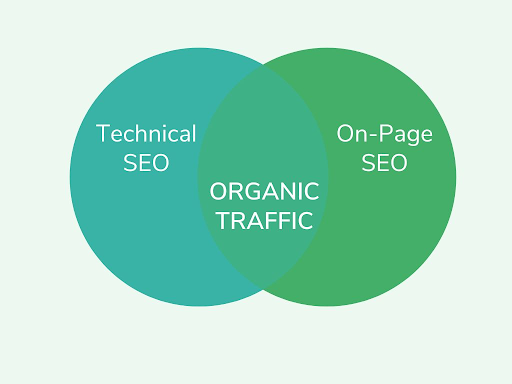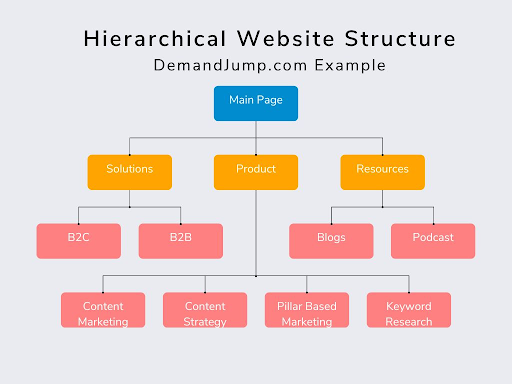What Is Technical SEO?
March 17, 2023 •Erica Kempf

Technical Search Engine Optimization is the SEO strategy of improving the parts of your website that allow it to be crawled, indexed, and ranked in search engines. In other words, technical SEO is the nuts-and-bolts coding part of a website that search engine bots look at to:
- Figure out what your website is about
- Decide if it is going to give searchers a good user experience
In this blog we’ll go through exactly what that means, the importance of technical SEO, and how you can improve this for your own website.
What Is the Definition of Technical SEO?
Technical SEO is all about making it easy for search engine spiders (sometimes called crawlers or bots) to understand and categorize your website. The easier you make this for them, the more likely it is that your website will show up highly on search results, improving your organic rankings.
It’s easy to get confused about the difference between technical and on-page SEO, since both are related to things on your website that help with organic rankings. One way to think about the difference is that technical SEO is about helping robots know how to categorize your website, and on-page SEO is about writing content that humans will find useful. Another way is to think about technical SEO as the back-end of your website, the part invisible to users—while on-page SEO is the stuff people actually see with their eyeballs on your site.

The overall goal of SEO is to improve how a website shows up on search engines. The different types of SEO just go about it in different ways. Search engines being able to automatically categorize and index your site (technical SEO) is necessary in order for the well-written content you have there (on-page SEO) to show up when someone searches for it.
What Are the Main Technical SEO Factors?
There are many specific elements that go into making your website easy to crawl, rank, and index. To create and execute a good technical SEO strategy, you’ll want to consider as many of these factors as you can. Some of the most important are:
- Site speed
- Site security
- Mobile friendliness
- Site structure
- No crawl-stopping code
- No (or few) dead links
- No duplicate content
How to Do Technical SEO
Knowing what factors are important for technical SEO is only half the story, however. It’s just as important to know how to improve these factors on your website so you can reap the benefits of better SEO.
Here are some examples of technical SEO best practices for each of the seven important factors established above, along with some helpful technical SEO tools to make them easier to achieve.
- Speed - Use Google’s PageSpeed Insights to see how fast your site is currently loading. Improve speed by:
- Compressing images
- Minifying your code, which cuts down white space and unneeded characters and makes file size smaller
- Using a content distribution network that holds webpage copies on servers worldwide—reducing travel distance
- Security - Make sure your site runs with HTTPS, the secure version of HTTP. Look for the lock symbol in the left corner of the address bar on your website. If it gives a “Not Secure” message instead, use a tool like CloudFlare to get your SSL certificate for free. Once you begin running with higher security, search engines will stop penalizing your less secure site in results.
- Mobile Friendly - Use a responsive layout for your website that will automatically change when users access it on mobile devices. Search engines prioritize this, since for the last six years 50% or more of users access sites on mobile devices. Most of the big website building platforms offer this feature, like Squarespace and Wordpress.
- Structure - Organize your website’s pages in a way that crawlers can easily understand. A hierarchical structure works best, with a main page, then several broad category pages with individual blogs or landing pages underneath. Avoid orphan pages or pages that require many clicks to access from the main page.

- No crawl-preventing code - Ensure that none of your web pages include a “noindex” code if you want them to show up in search results. This code can be used for things like Thank You pages that you do not want to be included in search results.
- No dead links - Review your website regularly and remove broken or dead links. Search engines will penalize sites with a high number of these.
- No duplicate content - Ensure that only one version of your website shows up for users and spiders. This includes doing things like:
- Making sure there is only one version of your website available to crawlers (like your http site redirects to https version)
- Removing repetitive pages that appear in multiple places on your sitemap
- Checking for internal plagiarism, avoid copy and pasting exact text in multiple places on your website
Don’t Forget About the Other Types of SEO
Once you have a great technical SEO strategy in place, make sure you’ve got great content so people can find your site and want to stay on! A complete SEO strategy needs to include great content that people want to read, and the elements that make it show up on search engines. DemandJump’s platform helps you find the exact topic clusters and keywords for writing content your audience is looking for. Combining this with best practices for technical SEO means you’ve got a winning strategy for showing up at the top of results pages. See what we have to offer today with a free trial!
Featured Articles
Categories
- Attribution Tracking (13)
- Channel Optimization (11)
- Consumer Insights (68)
- Content Marketing (251)
- Data Science (8)
- Digital Marketing (6)
- Digital Transformation (26)
- Enterprise (10)
- Lead Generation (14)
- Market Intelligence (8)
- Marketing Analytics (39)
- Marketing Attribution (57)
- Marketing Management (153)
- Marketing Operations (86)
- Organic Search (222)
- Paid Search (52)
- Pillar-Based Marketing (63)
- Programmatic Advertising (9)
- SaaS Content (14)
- SaaS Marketing (29)
- Search Marketing (111)
- SEO Keyword Research (28)
- SEO Pillar (18)
- SEO Strategy (46)
- SMB (5)
- Website Content (12)


